
Adventures in Wellness: The Joy of Floating
Flotation therapy was popular during the 80s, when I was in college, and now seems to be making a comeback. I wanted to find out why. What would an hour in a sensory deprivation float tank be like, completely alone with your thoughts, in total silence and total darkness: Relaxing? Claustrophobic? Well, I tried it, and here is my take: I loved it! If there is one word to describe this experience it is… Zen
 Dr. David Berv, who owns Float Zone in Richmond, VA is such an advocate of floatation therapy and such a believer of its benefits, that he changed the course of his profession in order to bring this alternative healing art to the local community.
Dr. David Berv, who owns Float Zone in Richmond, VA is such an advocate of floatation therapy and such a believer of its benefits, that he changed the course of his profession in order to bring this alternative healing art to the local community.
To find out more, I initially accessed the Float Zone web site at www.myfloatzone.com.
Word Appeal
Dr. Berv and the other founders share their personal experiences and describe the benefits of floating, using very intriguing words like: rejuvenation, getting back into balance, both calming and energizing, meditative, connecting with yourself, being able to hear and listen to your inner voice, gaining focus, letting go of the noise, relaxation and recovery…peace.
These words only made me more curious. I booked my first float.
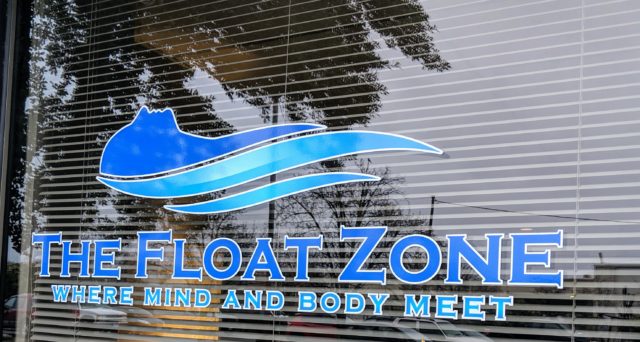 What’s it Like?
What’s it Like?
It is a bit hard to explain what sensory deprivation feels like, because I have never experienced anything like it. In our modern world, it is almost impossible to be without light or noise…let alone without the constant stimulation provided by our “devices”. My best answer is that this sojourn makes you think differently. It alters your perspective in a positive way when you fully, completely, let go of the sensory overload of everyday life. Disconnecting may be a disconcerting concept for some people, but I found my hour in the tank to be a very welcome relief.
And this is exactly why Dr. Berv feels it is so healing and so beneficial.

The Story Behind the Vision
Dr. Berv is a pioneer in the world of alternative medicine here in Richmond, VA. He often makes the region’s “best of” lists”—Best Doctor, Best Chiropractic Clinic, Best Bedside Manner—to name a few. As a chiropractor, he specialized in training and treating high-level athletes. He has always sought to offer whole body healing solutions to those suffering from both physical and mental pain.
In recent years, the doctor became the patient and he was forced to seek healing on his own behalf. David was struggling to cope not only with the chronic pain of a debilitating back injury, but with the unsteadiness and uncertain future posed by the effects of Multiple Sclerosis…all while trying to keep up with a demanding chiropractic career. It left him close to mental and physical collapse.
While visiting a family member in Colorado, he was introduced to floatation therapy and noticed a profound change almost immediately. It was the first real relief he had ever experienced. The mental calm and clarity helped fuel healing,
He said, “I emerged from the flotation session with a significant reduction in pain, along with such an uplifted and relaxed emotional state…It was transforming.”
 Why Does It Work?
Why Does It Work?
I have become interested in alternative healing therapies myself recently, as I and loved ones have had health issues that have not responded all that well to traditional medicine.
My immediate question was: What is the source of the healing? Is it the fact that your body is suspended and therefore weight is lifted from your limbs, spine and organs? Is it the high concentration of salt in the water? Is it the absence of sensory stimulation?
All are at play, but Dr. Berv feels that quiet is the real key. There are a lot of negative physical manifestations of a body in constant “overdrive” — chronic stress and pain being chief among these. Our “fight or flight” response is always engaged in our world. The tank totally removes the sensory overload that triggers such a response and provides a stressless environment.
What he had to say about the topic resonated:
“When in pain or in times of great stress, people are increasingly turning to non-medical intervention that massage, yoga, mindfulness and meditation provide. People operating in a frenetic society need short periods of reflection—efficient stress relief, where the body is calm, and the mind can refresh. Flotation is another valuable tool in that healing toolbox.”
Floatation therapy is an excellent complement to enhance other practices such as yoga and meditation. Dr. Berv notes that while yoga is perfectly fine after a float, a strenuous workout with weights is definitely not recommended.
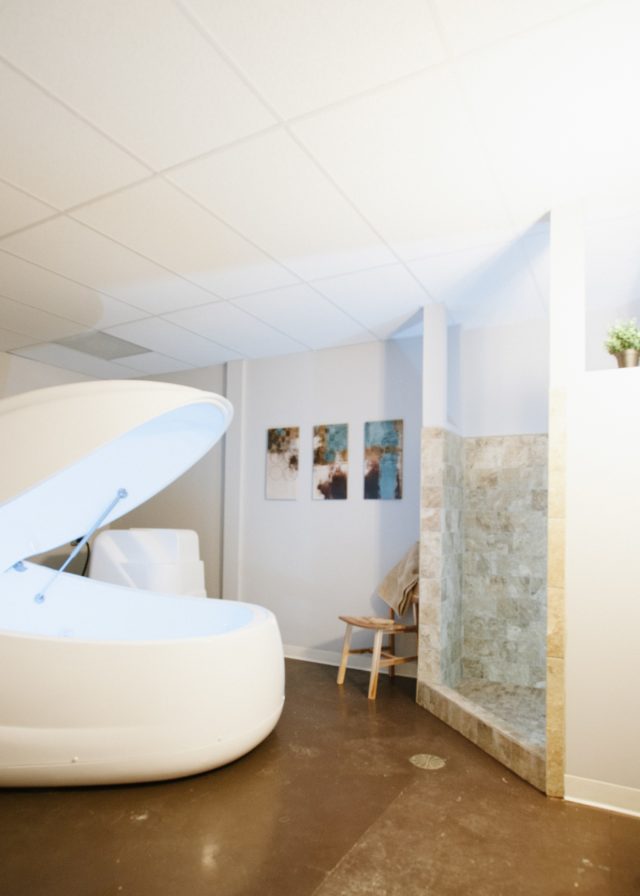 Floatation as Healing Therapy
Floatation as Healing Therapy
In the years since Dr. Berv discovered floating, he has turned his attention toward sharing this healing method to others, who have gained relief for a myriad of ailments. He is actually one of the few professionals in the industry doing case studies and collecting data regarding the myriad positive effects of float therapy. ( https://www.myfloatzone.com/casestudy).
He specifically mentions how it can address not only anxiety and stress reduction, but issues such as PTSD, because the experience can help “rewire” fear. Flotation is a totally non-medical intervention that has no negative side effects. It may alleviate symptoms associated with autism and opioid addiction. Sports centers are incorporating flotation therapy to increase athletic performance and aid in healing injuries.
Floating can also be very beneficial to achieving good sleep. It mimics the first and second stages of sleep, a mentally restorative time. In the tank, one can finally, completely be peaceful, without the constant barrage that makes up everyday life. The deep meditative state inspires introspection, mental clarity, and increased problem-solving ability. Because the float session can clear the mind of clutter, often clients feel they get their best ideas, their “aha” moments in the float tank.
While I was talking with Dr. Berv, a client who had just finished a float session sat down beside us and when asked how she liked the experience, she responded: “This is the most relaxing, recharging experience. I am going into a meeting where I have to deliver a presentation, and I am not even nervous. I feel more present, more aware, more centered.”
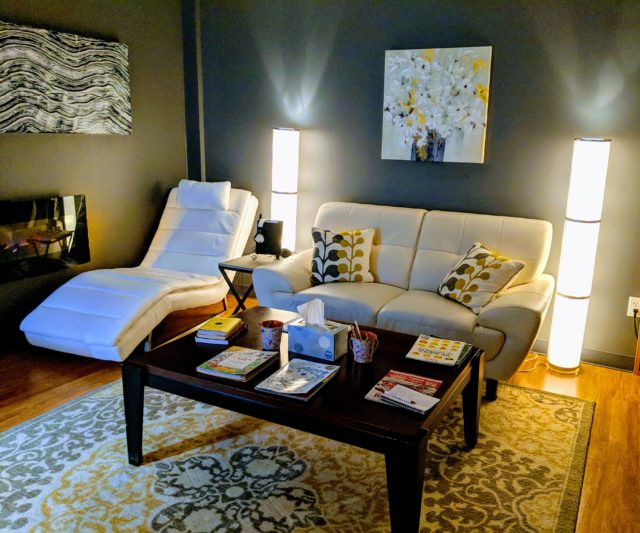 The Studio
The Studio
The Float Zone studio is beautiful. The location, an unassuming storefront in Richmond, surrounded by industrial businesses, belies the calm and pristine space inside the door. Adjacent to the lobby is a lovely “relaxation” room, with a gas fireplace and a comfortable sofa and chairs, where guests are welcome to stay for as long as they wish after therapy, to continue to experience calm before venturing out into the noisy world all over again.
 There are 4 floatation rooms, each with its own tank. Here is how it works:
There are 4 floatation rooms, each with its own tank. Here is how it works:
Each room has a large stone shower stall in addition to the tank. Everything is absolutely spotless. You shower before entering the tank as you float in the nude, and then again afterward to wash off the salt. After each session, the water in the tank is completely filtered and cleansed.
 In the tank, you naturally, effortlessly float. There are 1,000 pounds of salt in each tank, which each hold 175 gallons of water. This high salt content creates the buoyancy.
In the tank, you naturally, effortlessly float. There are 1,000 pounds of salt in each tank, which each hold 175 gallons of water. This high salt content creates the buoyancy.
Inside the Tank
I wondered if the tank would feel claustrophobic, but I did not personally find it to be so. You can close the tank completely and have total darkness and total silence. Of course, if that is uncomfortable you can leave the tank open or just slightly cracked and the low lights will stay on. The controls are directly by your right hand, so you can adjust the music and the lighting. In any kind of emergency, you can contact the front desk immediately with a call button. I chose to have the meditative music playing, which I actually found more relaxing and Zen than total silence, but wanted the tank closed for total darkness.
Dr. Berv noted that it would take a little while for the calm and mental quieting to happen, as one’s thoughts typically bounce all over the place all the time. But after 10 or 15 minutes, my mind did indeed calm. He said many people actually fall asleep, and often totally lose track of time. I did not fall asleep, but I mentally went “somewhere else” for sure–kind of a small out of body experience is how I would describe it. I can also say I feel centered after a float, more present, more aware.
The typical float time is 60 minutes. When the session is over you are gently reminded, as the lights softly come back on in the tank and a calm voice tells you to slowly emerge.
The Magic of Three
Dr. Berv suggested I try floating at least 3 times and here’s why: The first experience is about getting used to the tank and how it all feels. And because it is so unlike any other experience, your mind and body need to process and adjust. The second time you know what to expect and can more freely allow your mind and body to let go. And after that, you simply become more adept to doing so and can start truly appreciating the benefits.
I came away with a sense of serenity that lasted a nice long time after each session, but I agree that subsequent visits make the experience mentally “click”. I liken it to the practice of mediation, which took awhile to resonate with me–mental calm does not come easily. But after the third session, I definitely started to feel it. Plus, this third session happened to fall right after I had made my way back to the gym and was feeling the muscle soreness and strain—I was feeling my age, as they say, and the tank offered both physical and mental calming effects.
Would I recommend flotation therapy? Absolutely yes.
Especially for Baby Boomers
And what does all this mean for Baby Boomers? Dr. Berv treats many clients who recognize the unwelcome signs of aging and tell him: “I had it, I lost it, and I want it back.” I wager this is the mantra of the Baby Boomer generation. David notes the physical effects of aging, and floating can help all of them.
As they seek the fountain of youth, Boomers need to pay attention to the state of mind that comes with increasing joint pain and the loss of physical capability. Floats can help prevent the downward spiral. “The experience can help with faster recovery of injuries,” says David. “It can help you jump higher, do more.”
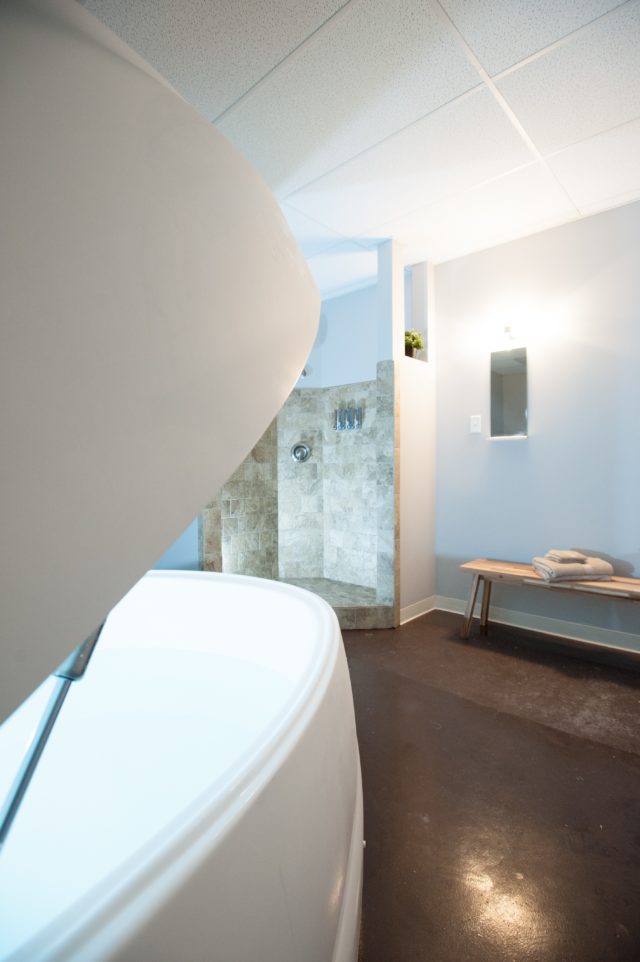 Flotation Therapy Makes A Comeback
Flotation Therapy Makes A Comeback
As mentioned, flotation therapy is not new by any means. I remember it trending in the 80s. The industry faltered, largely because the AIDS epidemic raised fears of sharing such common spaces, and was more or less dormant after the early 90s. However, research emerged supporting the benefits of this therapy, and around 2010 the filtration technology was perfected. Interest grew, helped along by social media.
Joe Rogan, in his popular podcast, started touting the benefits of floating, http://podcasts.joerogan.net/
Plus, professional sports trainers and therapists began using flotation therapy. Since 2016, the industry has quickly expanded, along with a population open to alternative therapies. The future of floating appears strong.
Pricing
As far as pricing, 1-hour floats cost $65, with an introductory float at $49. Various packages are available, which can be found on the web site or by calling Float Zone at: 804-551-1413.
Further research on floating can be found at: www.clinicalfloatation.com
My curiosity is finally satisfied. Now I know what it is like to completely step away from the daily fracas for an hour and regroup. It’s a beautiful thing.
`

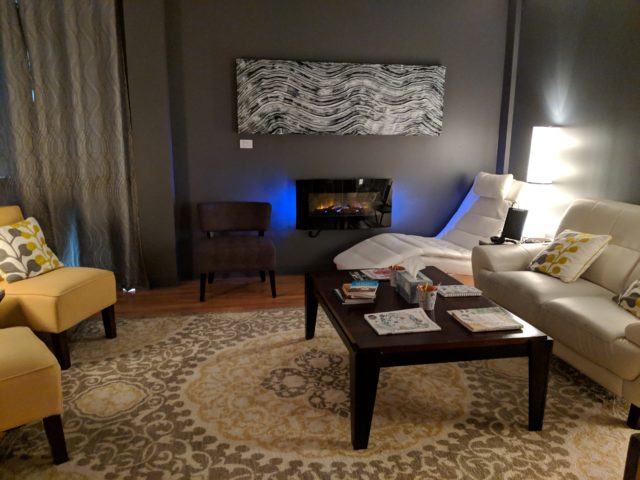
It’s the best time to make some plans for the long run and it’s time to be happy.
I’ve read this put up and if I may I desire to counsel you some attention-grabbing issues or suggestions.
Maybe you can write next articles regarding this article.
I desire to read even more issues about it!